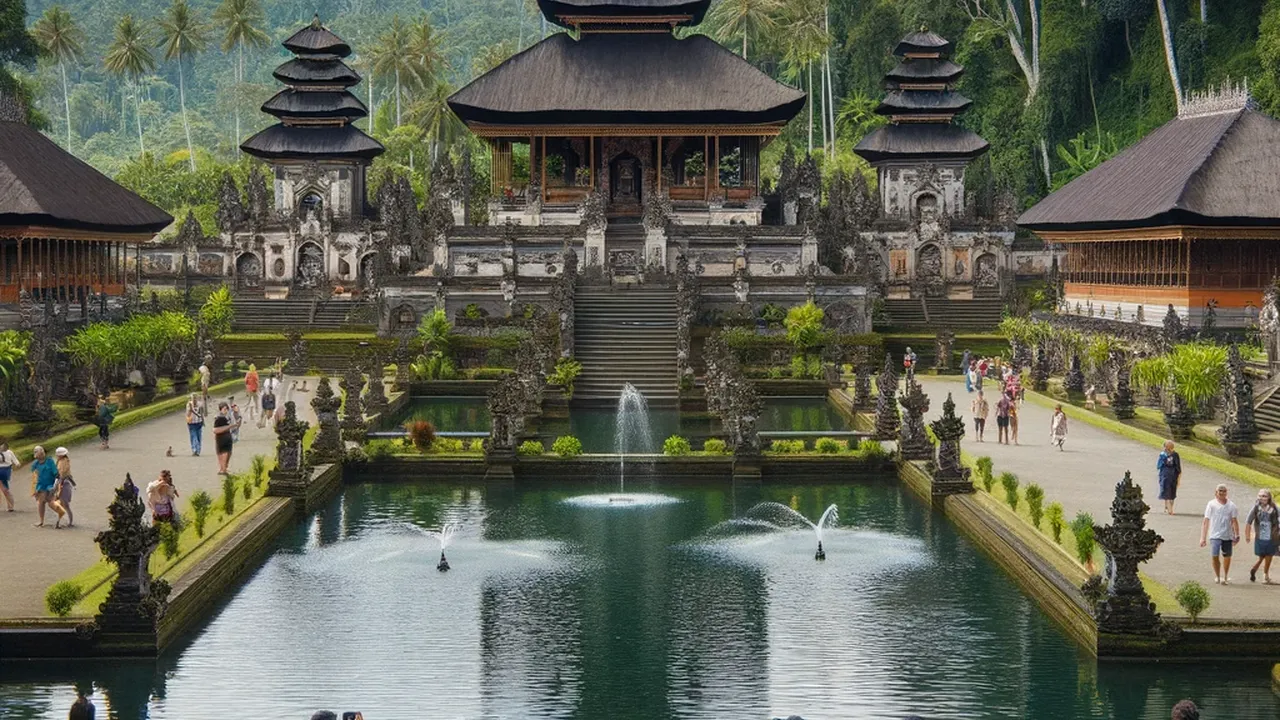
Discover Ujung Park of Karangasem in Bali
Nestled in the serene landscapes of Eastern Bali, the Ujung Park of Karangasem stands as a splendid testament to the island’s rich history and cultural heritage. Originally built as a royal water garden, this historical site blends architectural marvels from Balinese, European, and Chinese influences. Visitors to Ujung Park are treated to an immersive journey through the lush gardens, sprawling water features, and intricate structures that speak volumes of Bali’s past royalty. This hidden gem offers a unique perspective on Balinese history, making it a must-visit destination for enthusiasts of historical tourism.
Read Also: How many Gili Islands are there and Can you travel between the Gili Islands?
Unveiling the Majesty of Ujung’s Heritage
The Ujung Park of Karangasem, often overlooked in the bustling tourist landscape of Bali, is a repository of the island’s royal heritage. Built in the early 20th century by the King of Karangasem, it served both as a recreational spot for the royal family and a symbol of their sophisticated taste and power. The park’s design is a unique blend of Balinese, Dutch, and Chinese architectural styles, reflecting a period when Bali was embracing foreign influences while maintaining its cultural identity. This majestic complex, with its grand pavilions and elegant water features, offers a glimpse into the luxurious lifestyle of Balinese royalty.
The main attraction of Ujung Park is its central pond and the large ‘Bale Kambang,’ or floating pavilion. Surrounded by large pools and connected by intricate bridges, the pavilion stands as a testament to the architectural ingenuity of the era. The park also features several large ponds, each intricately designed and decorated with a variety of Balinese sculptures, adding to the aesthetic appeal of the site. These elements together create a serene and picturesque environment, inviting visitors to contemplate the grandeur of Bali’s past.
Apart from its architectural beauty, Ujung Park is steeped in history. The site has withstood the tests of time, including the eruption of Mount Agung in 1963 and a subsequent earthquake, each time being carefully restored to preserve its historical significance. Today, it serves as a cultural hub, hosting various local art and cultural events that celebrate and perpetuate the rich heritage of Bali. For history enthusiasts, the park is not just a site of beauty, but a living museum that narrates the story of a bygone era in Balinese history.
Read Also: Where do Couples go in Bali?
A Historical Journey in Ujung Park
Embarking on a visit to Ujung Park of Karangasem is akin to stepping back in time to witness the grandeur of Bali’s royal era. The park’s origins date back to the reign of King Gusti Bagus Jelantik in the early 1900s, who envisioned it as a symbol of regal opulence and serenity. The park, initially a private retreat for the royal family, gradually transformed into a stunning water garden, showcasing the harmonious blend of Balinese and European architecture. Its rich history is palpable in every corner, from the meticulously designed water palaces to the ornate statues that adorn its grounds.
Exploring Ujung Park is a journey through various historical layers, each telling a unique story. The main palace, with its intricate Balinese carvings, stands as a proud reminder of the island’s artistic traditions. The surrounding gardens, designed with European influences, feature a series of ponds and fountains, creating a tranquil and harmonious setting. This fusion of styles reflects the cultural openness of Bali’s royalty, embracing external influences while preserving their indigenous identity.
The park also serves as a living testament to Bali’s resilience through adversity. It has endured natural disasters, including the devastating eruption of Mount Agung in 1963, which caused significant damage. The restoration efforts undertaken since then have not only repaired but also revitalized the park, ensuring its historical essence is preserved for future generations. Visitors can witness the painstakingly restored structures, which continue to stand as symbols of the island’s enduring spirit.
In addition to its historical and architectural significance, Ujung Park offers a tranquil escape from Bali’s more crowded tourist destinations. The park’s expansive gardens and reflective pools provide a peaceful retreat, inviting visitors to reflect on the rich history that surrounds them. Strolling through the park, one can’t help but feel connected to the centuries of history that have shaped this majestic site, making it an essential stop for anyone interested in the historical journey of Bali.
Read Also: Everything You Need to Know Before Visiting Ubud Monkey Forest
Karangasem’s Hidden Gem: Ujung Park Explored
Ujung Park, nestled in the district of Karangasem, is one of Bali’s most understated yet captivating attractions. Often overshadowed by more famous sites, this park offers a tranquil respite from the island’s bustling tourist hotspots. It is a place where nature and history merge seamlessly, creating a serene environment that’s both aesthetically pleasing and culturally rich. The park, with its lush greenery and quiet ponds, provides an ideal setting for those seeking a moment of peace amidst historical surroundings.
This hidden gem’s history is as intriguing as its beauty. Originally constructed as a part of the Karangasem Royal Palace, it was designed to be a place of rest and relaxation for the king and his guests. Over the years, Ujung Park has evolved, embodying the changing times and rulers, yet it has always maintained its core essence as a symbol of regal elegance. The architecture here is a testament to the artistic and cultural influences that have shaped Bali over the centuries.
One of the unique features of Ujung Park is its water palace, which is a fine example of traditional Balinese architecture blended with Dutch colonial styles. The palace is surrounded by three large pools, each offering a different perspective of the park and its lush landscapes. The intricate design of the water features and the strategic placement of statues and pavilions create a sense of harmony and balance, typical of Balinese aesthetics.
Visitors to Ujung Park are treated not just to a visual feast but also to an immersive historical experience. The park’s pathways and bridges lead guests through a journey that encapsulates the essence of Bali’s royal past. Each step reveals a new vista, a different angle of the park’s beauty, making it a photographer’s paradise. It’s a place where history is felt, not just seen, making Ujung Park a must-visit for those seeking to understand the depth and diversity of Bali’s cultural heritage.
Read Also: 10 Must-Do Daytime Activities for Your Next Adventure

Historical tourism in Bali finds one of its most enchanting expressions in Ujung Park of Karangasem, a hidden gem that beautifully encapsulates the island’s rich heritage and architectural grandeur. This serene oasis, blending traditional Balinese and Dutch colonial architecture, stands as a testament to Bali’s royal past and cultural resilience. Its lush gardens, tranquil water features, and the harmonious blend of nature and history offer visitors a unique and immersive experience. As a cornerstone of historical tourism in Bali, Ujung Park not only provides a tranquil escape from the more frequented tourist paths but also serves as a vivid reminder of the island’s diverse and vibrant history, making it an indispensable part of any cultural exploration of Bali.


